Abstract
The tobacco N and Arabidopsis RPS2 genes, among several recently cloned disease-resistance genes, share highly conserved structure, a nucleotide-binding site (NBS). Using degenerate oligonucleotide primers for the NBS region of N and RPS2, we have amplified and cloned the NBS sequences from soybean. Each of these PCR-derived NBS clones detected low-or moderate-copy soybean DNA sequences and belongs to 1 of 11 different classes. Sequence analysis showed that all PCR clones encode three motifs (P-loop, kinase-2, and kinase-3a) of NBS nearly identical to those in N and RPS2. The intervening region between P-loop and kinase-3a of the 11 classes has high (26% average) amino acid sequence similarity to the N gene although not as high (19% average) to RPS2. These 11 classes represent a superfamily of NBS-containing soybean genes that are homologous to N and RPS2. Each class or subfamily was assessed for its positional association with known soybean disease-resistance genes through near-isogenic line assays, followed by linkage analysis in F2 populations using restriction fragment length polymorphisms. Five of the 11 subfamilies have thus far been mapped to the vicinity of known soybean genes for resistance to potyviruses (Rsv1 and Rpv), Phytophthora root rot (Rps1, Rps2, and Rps3), and powdery mildew (rmd). The conserved N- or RPS2-homologous NBS sequences and their positional associations with mapped soybean-resistance genes suggest that a number of the soybean disease-resistance genes may belong to this superfamily. The candidate subfamilies of NBS-containing genes identified by genetic mapping should greatly facilitate the molecular cloning of disease-resistance genes.
Full text
PDF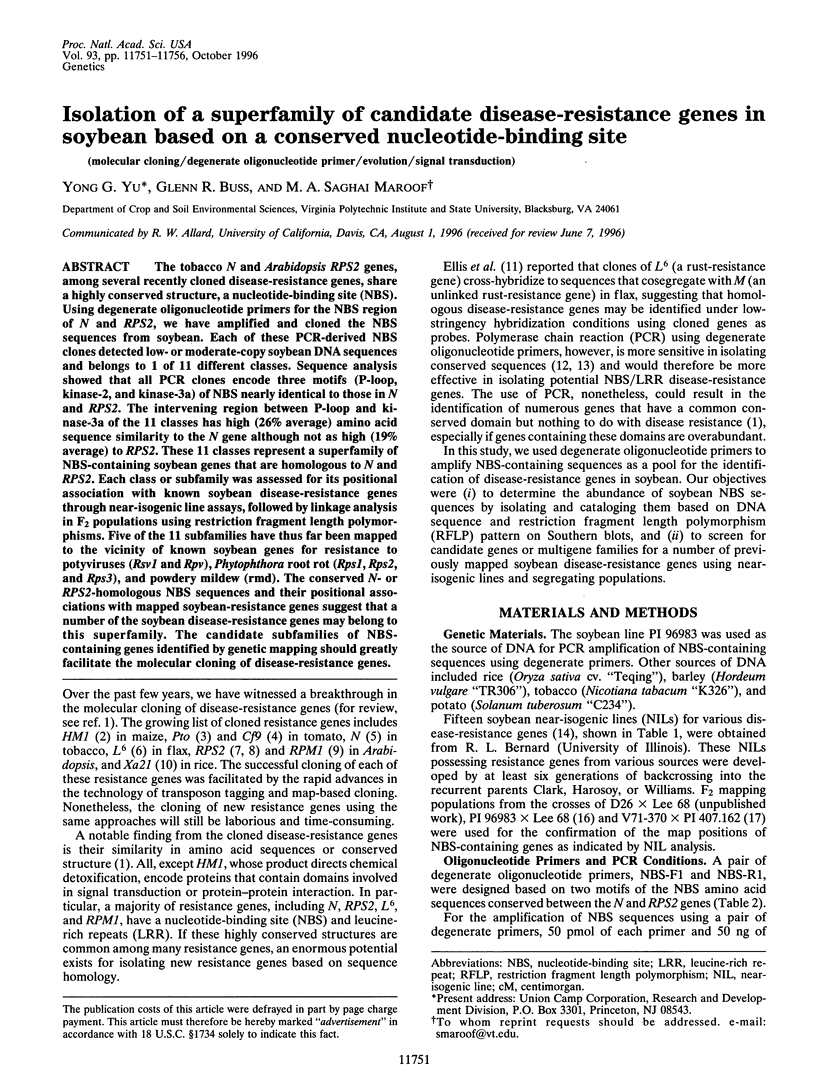
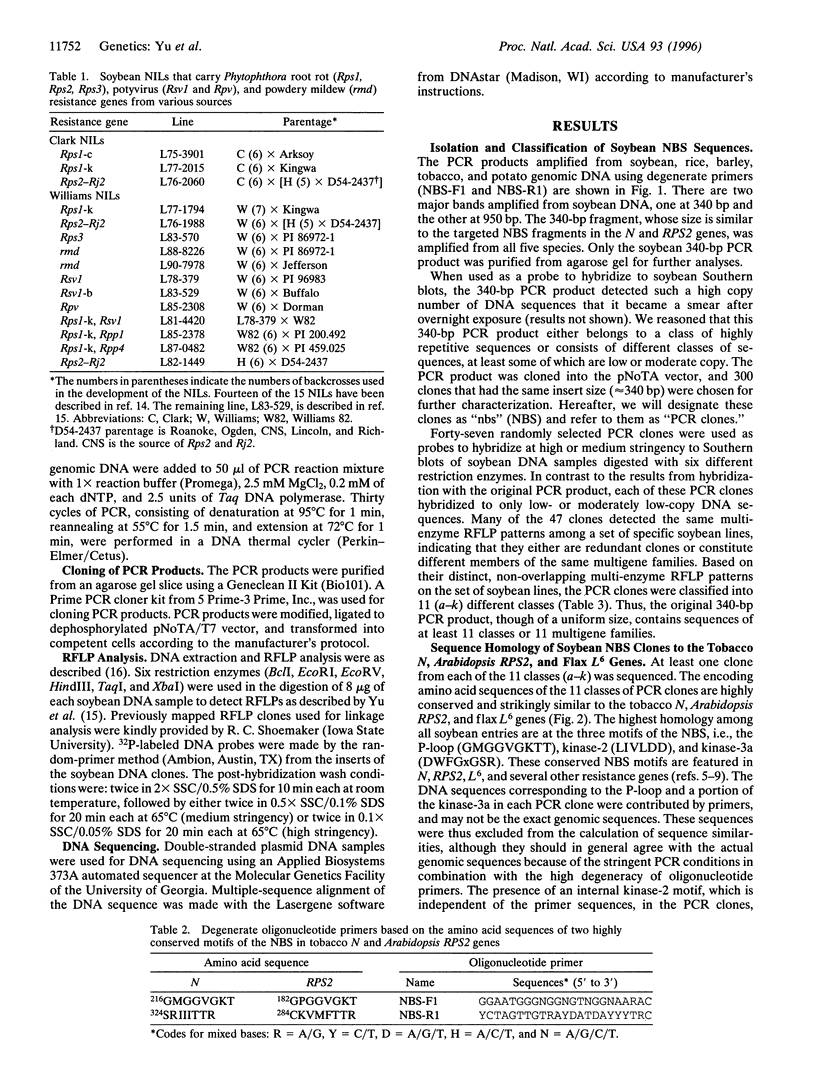
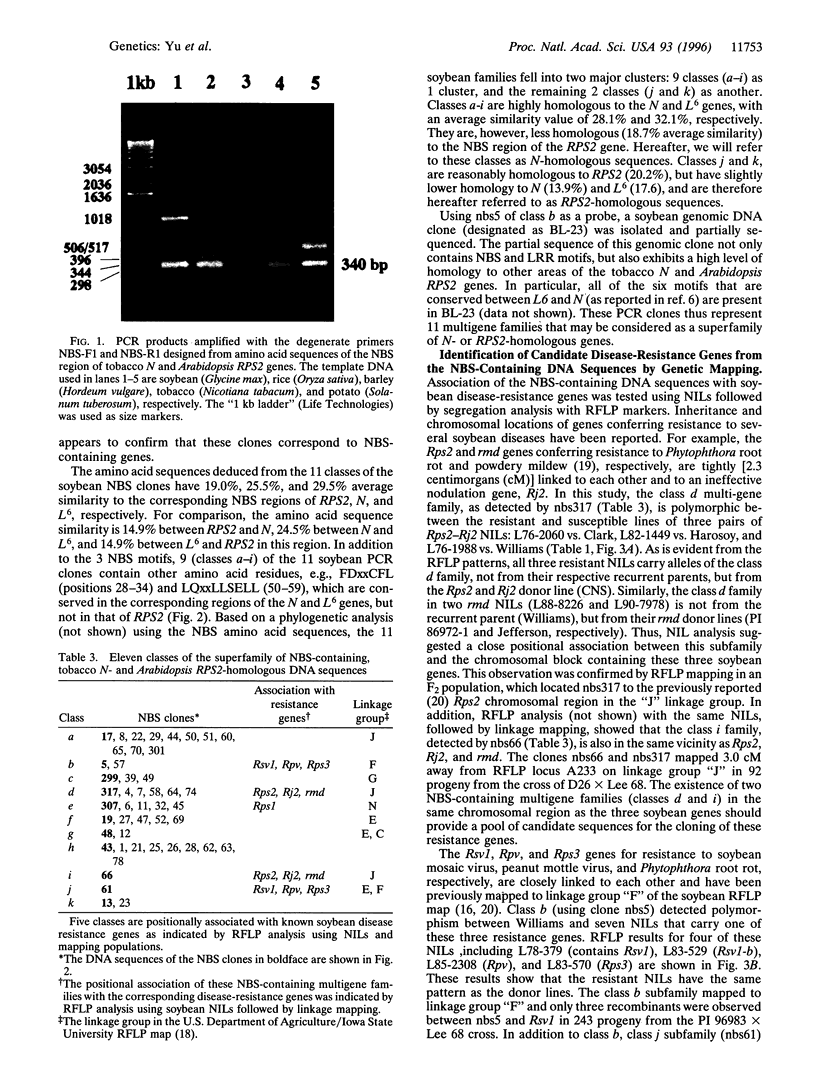
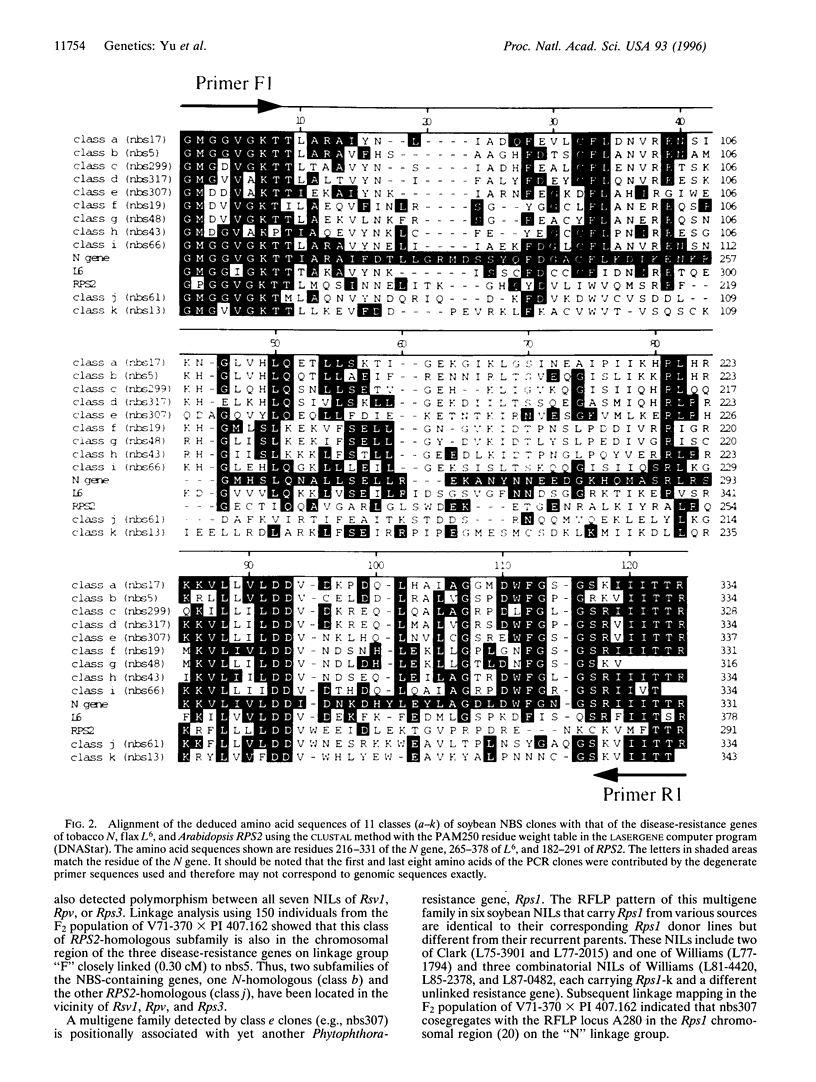
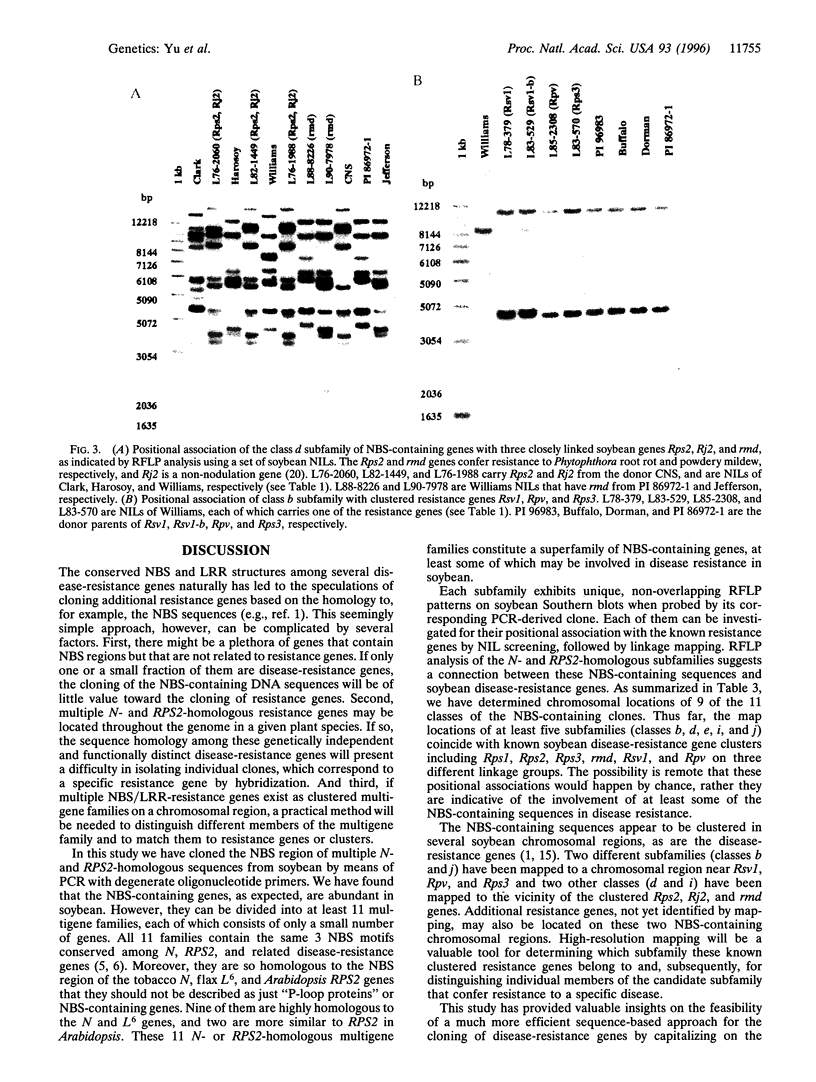
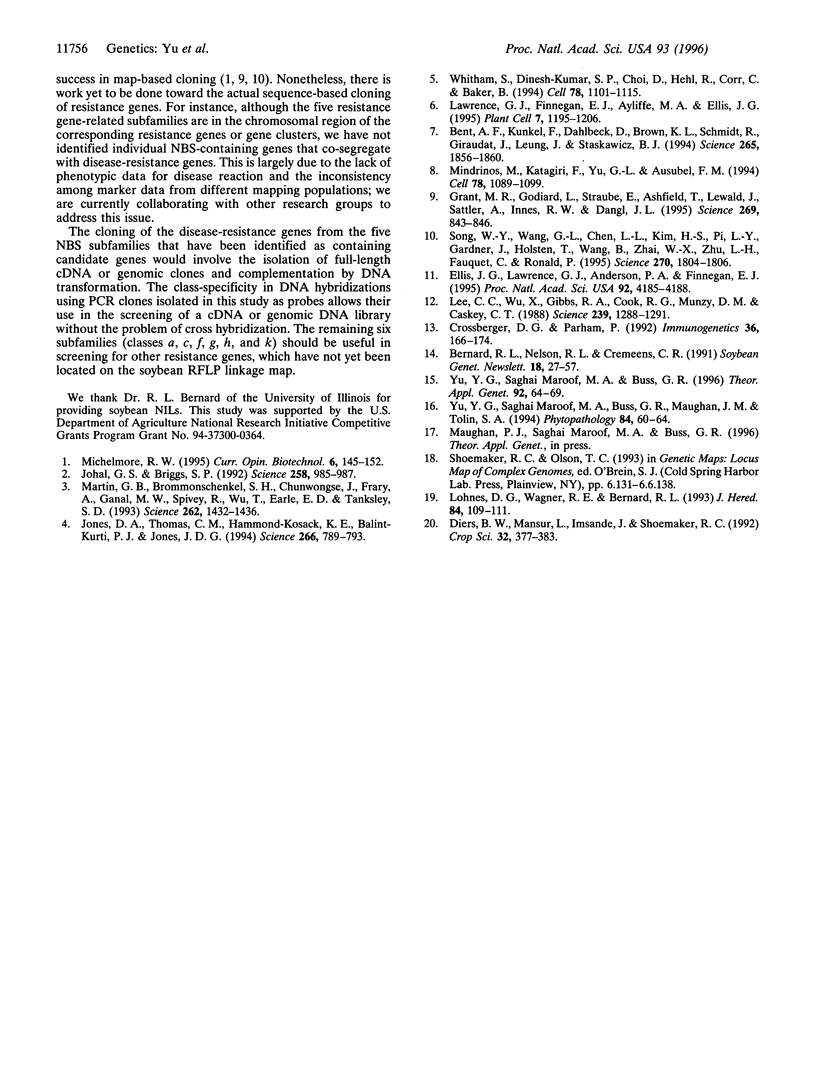
Images in this article
Selected References
These references are in PubMed. This may not be the complete list of references from this article.
- Bent A. F., Kunkel B. N., Dahlbeck D., Brown K. L., Schmidt R., Giraudat J., Leung J., Staskawicz B. J. RPS2 of Arabidopsis thaliana: a leucine-rich repeat class of plant disease resistance genes. Science. 1994 Sep 23;265(5180):1856–1860. doi: 10.1126/science.8091210. [DOI] [PubMed] [Google Scholar]
- Ellis J. G., Lawrence G. J., Finnegan E. J., Anderson P. A. Contrasting complexity of two rust resistance loci in flax. Proc Natl Acad Sci U S A. 1995 May 9;92(10):4185–4188. doi: 10.1073/pnas.92.10.4185. [DOI] [PMC free article] [PubMed] [Google Scholar]
- Grant M. R., Godiard L., Straube E., Ashfield T., Lewald J., Sattler A., Innes R. W., Dangl J. L. Structure of the Arabidopsis RPM1 gene enabling dual specificity disease resistance. Science. 1995 Aug 11;269(5225):843–846. doi: 10.1126/science.7638602. [DOI] [PubMed] [Google Scholar]
- Grossberger D., Parham P. Reptilian class I major histocompatibility complex genes reveal conserved elements in class I structure. Immunogenetics. 1992;36(3):166–174. doi: 10.1007/BF00661093. [DOI] [PubMed] [Google Scholar]
- Johal G. S., Briggs S. P. Reductase activity encoded by the HM1 disease resistance gene in maize. Science. 1992 Nov 6;258(5084):985–987. doi: 10.1126/science.1359642. [DOI] [PubMed] [Google Scholar]
- Jones D. A., Thomas C. M., Hammond-Kosack K. E., Balint-Kurti P. J., Jones J. D. Isolation of the tomato Cf-9 gene for resistance to Cladosporium fulvum by transposon tagging. Science. 1994 Nov 4;266(5186):789–793. doi: 10.1126/science.7973631. [DOI] [PubMed] [Google Scholar]
- Lawrence G. J., Finnegan E. J., Ayliffe M. A., Ellis J. G. The L6 gene for flax rust resistance is related to the Arabidopsis bacterial resistance gene RPS2 and the tobacco viral resistance gene N. Plant Cell. 1995 Aug;7(8):1195–1206. doi: 10.1105/tpc.7.8.1195. [DOI] [PMC free article] [PubMed] [Google Scholar]
- Lee C. C., Wu X. W., Gibbs R. A., Cook R. G., Muzny D. M., Caskey C. T. Generation of cDNA probes directed by amino acid sequence: cloning of urate oxidase. Science. 1988 Mar 11;239(4845):1288–1291. doi: 10.1126/science.3344434. [DOI] [PubMed] [Google Scholar]
- Martin G. B., Brommonschenkel S. H., Chunwongse J., Frary A., Ganal M. W., Spivey R., Wu T., Earle E. D., Tanksley S. D. Map-based cloning of a protein kinase gene conferring disease resistance in tomato. Science. 1993 Nov 26;262(5138):1432–1436. doi: 10.1126/science.7902614. [DOI] [PubMed] [Google Scholar]
- Mindrinos M., Katagiri F., Yu G. L., Ausubel F. M. The A. thaliana disease resistance gene RPS2 encodes a protein containing a nucleotide-binding site and leucine-rich repeats. Cell. 1994 Sep 23;78(6):1089–1099. doi: 10.1016/0092-8674(94)90282-8. [DOI] [PubMed] [Google Scholar]
- Song W. Y., Wang G. L., Chen L. L., Kim H. S., Pi L. Y., Holsten T., Gardner J., Wang B., Zhai W. X., Zhu L. H. A receptor kinase-like protein encoded by the rice disease resistance gene, Xa21. Science. 1995 Dec 15;270(5243):1804–1806. doi: 10.1126/science.270.5243.1804. [DOI] [PubMed] [Google Scholar]
- Whitham S., Dinesh-Kumar S. P., Choi D., Hehl R., Corr C., Baker B. The product of the tobacco mosaic virus resistance gene N: similarity to toll and the interleukin-1 receptor. Cell. 1994 Sep 23;78(6):1101–1115. doi: 10.1016/0092-8674(94)90283-6. [DOI] [PubMed] [Google Scholar]




